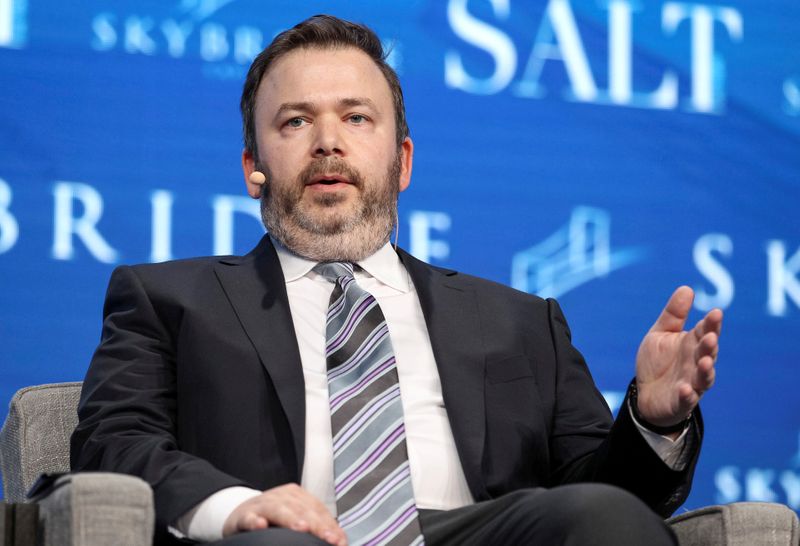By Svea Herbst-Bayliss and Lawrence Delevingne
(Reuters) - Boaz Weinstein was waiting for this.
The New York hedge fund manager, seasoned by past financial crises and spooked by seemingly endless quarters of ever-higher markets, had for years set up for financial calamity, even if it meant sometimes poor returns.
When panic over the coronavirus spread to global financial markets in late February, Weinstein swung into action.
Glued to a battery of computer screens to transact in three time zones for 15 hours a day, the former Deutsche Bank AG (DE:DBKGn) trader scored on bond and credit default swap-related bets and cashed in on old insurance-like derivatives products for a steep market decline, according to people who know him.
By Friday, Weinstein had produced the best returns in $2.7 billion (2.3 billion pounds) Saba Capital Management LP's history. Its Tail Fund gained more than 175% through March 13; other Saba funds gained between 53% and 67%, according to a client letter reviewed by Reuters https://www.reuters.com/article/us-hedgefunds-saba/boaz-weinstein-hedge-fund-up-33-after-market-plunge-letter-idUSKBN213015.
"I certainly did not expect it to come from a virus, but I have had the conviction – for a long time – that investors needed to be ready for an extreme market decline," Weinstein wrote in the letter that was sent to investors on Sunday.
A spokesman for Saba declined to comment.
Saba is among a small group of firms that have scored major returns for clients in recent weeks through so-called tail risk products.
The CBOE Eurekahedge Tail Risk Hedge Fund Index gained 14% in February alone and, combined with estimated March performance, is likely up between 32% and 41% for the year, according to a Eurekahedge analysis. See chart here https://fingfx.thomsonreuters.com/gfx/editorcharts/HEALTH-CORONAVIRUS-TAILRISK/0H001R8H7CDZ/index.html.
Goldman Sachs Group Inc (NYSE:GS) estimates that the average stock-focused hedge fund, by comparison, is down about 14% for the year through March 17, compared with a 25% benchmark stock market loss.
Tail products - including hedge funds, customised portfolios and exchange traded funds (ETFs) - typically use credit default swaps, stock options and other derivatives to profit from severe market dislocations. Generally they are cheap bets for a big, long-shot payoff that otherwise are a drag on the portfolio, much like monthly insurance policy payments. Such funds have been around since the 2008 financial crisis, but they gained limited traction by producing mixed returns during the bull market.
'MULTIPLES' OF 1,000%
A client of Universa Investments LP, a $4.1 billion Miami-based risk mitigation specialist, saw money allocated to the firm's tail hedging strategy gain around 1,000% in February and "multiples" of that in March, according to Claude Bovet of Lionscrest Capital. That implies a gain of at least 3,000%; the net return on Lionscrest's total portfolio was not available.
"This has been a great period for us and our clients," Universa chief investment officer Mark Spitznagel said via a spokesman, who declined to comment on performance.
Other big winners include Capstone Investment Advisors, whose $7 billion firm runs tail risk strategies for clients that have gained 280% this year through Monday, according to a person familiar with the returns; 36 South Capital Advisors' volatility strategy, which rose 35% over January and February, according to data from Societe Generale (PA:SOGN); and the $126 million Cambria Tail Risk ETF (Z:TAIL), which is up about 25% this year through Tuesday.
"Our tail risk products are doing exactly what they are designed to do," said Meb Faber, chief investment officer at El Segundo, California-based Cambria Investment Management LP.
Representatives for Capstone and 36 South declined to comment.
These types of portfolios are always popular during a crisis but when no next terrible event happens, investment managers and boards often lose patience and exit, complaining of low returns or losses. Last year, when the S&P500 stock index gained 30%, the benchmark CBOE Eurekahedge index lost 10.4%.
The gains this year are likely to spur renewed interest. Weinstein's Saba has seen $500 million come in this year and told investors that he will limit inflows into his funds to an aggregate of $1 billion for 2020. Weinstein said Saba was now "finding extraordinary new investments" amid the turmoil.
Winning managers were mindful that their gains came as a result of a health crisis that has sickened nearly 200,000 people around the world and killed 7,500 as of Wednesday, according to the World Health Organization https://experience.arcgis.com/experience/685d0ace521648f8a5beeeee1b9125cd.
"We provide protection, an effective safe haven," said Universa's Spitznagel. "But we certainly didn’t need nor want this tragedy to happen."
(Graphic: Doomsday 'tail risk' funds cash in - https://fingfx.thomsonreuters.com/gfx/editorcharts/HEALTH-CORONAVIRUS-TAILRISK/0H001R8H7CDZ/index.html)
